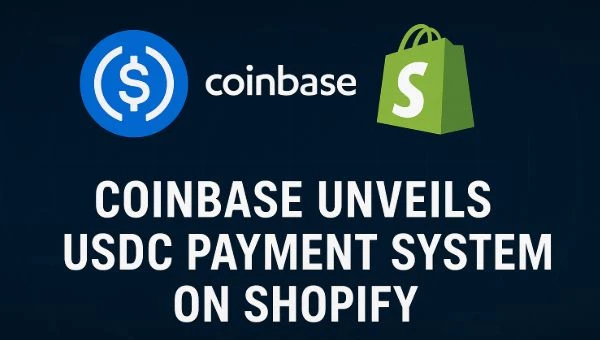

A Turning Point for Stablecoins
Coinbase Global Inc. has taken a bold step toward reshaping global payments. On June 18, 2025, the company launched a new USDC-powered payment system, offering merchants instant, low-cost digital transactions without the usual blockchain headaches.
The system runs on Coinbase’s Ethereum layer-2 network, Base, and is integrated directly into Shopify’s platform, giving millions of merchants access to crypto-native payments that feel just as seamless as credit card checkouts.

Coinbase’s timing couldn’t be better. Just one day before the launch, the U.S. Senate passed the long-awaited GENIUS Act, a bipartisan bill that formally recognizes dollar-pegged stablecoins under federal law.
This landmark move gave the green light for institutions to adopt stablecoins with confidence.
The market response was immediate. Circle, the company behind USDC, saw its stock (CRCL) jump 33.8%. Coinbase (COIN) rose 16%. The GENIUS Act still awaits House approval and President Trump’s signature, but its momentum is already being felt.
Against this backdrop, Coinbase’s new system is a strategic move to take advantage of a regulatory wave that’s legitimizing stablecoins as viable alternatives to traditional money.
With the regulatory foundation taking shape, Coinbase is moving fast to bring stablecoin payments into everyday use. The new system enables customers to pay in USDC through wallet-native checkouts, while merchants receive payouts in either fiat or stablecoins via API. Shopify began rolling out early access on June 13 and plans a broader launch later this year.
To lower the barrier for adoption, Coinbase has partnered with Stripe for instant crypto-to-fiat conversions. Merchants don’t need to manage wallets, hold tokens, or worry about price volatility. And customers get a 1% USDC cashback incentive, offering direct savings compared to PayPal’s typical 2–3% fees.
The integration is also gas-free, removing another technical hurdle for shoppers who might otherwise hesitate to use crypto at checkout.
This smooth checkout experience is a direct challenge to legacy processors. It takes stablecoins out of the hands of niche crypto users and puts them directly into retail.
Why Shopify’s Role Is Bigger Than It Looks
Shopify’s participation amplifies the impact of Coinbase’s launch. The platform supports millions of sellers globally, from indie boutiques to enterprise storefronts. With stablecoin transactions clearing in under a second, faster than most card payments, sellers can receive money instantly, across borders, and with no foreign exchange fees.
Shopify CEO Tobi Lutke called stablecoins “the internet’s natural currency.” While Shopify already supports Bitcoin and Ethereum through Coinbase, those assets often fluctuate wildly in price. USDC’s dollar peg makes it far more suitable for everyday commerce.
But Coinbase’s ambitions stretch well beyond shopping carts. On the same day it launched the Shopify payment stack, the company also announced a partnership between Coinbase Derivatives and Nodal Clear to begin using USDC as collateral in U.S. futures trading. The move is pending CFTC approval, expected in 2026.
If greenlit, this would be the first regulated use of a stablecoin as collateral in U.S. derivatives markets. Today’s clearinghouses rely on fiat, which slows down settlement and limits 24/7 market operations. By integrating USDC, Coinbase aims to unlock real-time margining, using its regulated custody infrastructure in New York for added security.
This initiative follows Coinbase’s rollout of 24/7 margined futures earlier this year, including nano Bitcoin and Ether contracts.
While BlackRock’s tokenized fund, BUIDL, has started to reshape how collateral is handled, USDC’s deep liquidity and regulatory structure give Coinbase a distinct advantage.
Real Risks Rising
Even with strong momentum, Coinbase’s stablecoin push won’t go unchallenged. Visa and Mastercard, both of which saw their shares dip 2% after the GENIUS Act passed, still dominate payments and will likely adapt rather than retreat.
Meanwhile, Bitedge’s crypto analysts warn that only exchange-backed stablecoins like USDC will be able to navigate tightening regulations. That could squeeze out smaller competitors and centralize power in a few hands.
Adoption hurdles also remain. Shopify’s USDC feature is still in early access, and a full rollout depends on merchant demand and regulatory clarity. While stablecoins moved $35 trillion last year, not all of that activity translated into consumer-level usage.
Crypto’s track record includes periods of overhype, and lessons from past bubbles, like the NFT boom of 2021, still linger.
The Shape of What’s to Come
Still, signs point to a lasting shift. With major retailers like Walmart and Amazon reportedly exploring their stablecoins, digital dollars are no longer a fringe experiment, but are gradually becoming part of the financial core.
Coinbase’s USDC payment system, boosted by Shopify’s massive reach and newly defined legal guardrails, could be the clearest signal yet that stablecoins are going mainstream.
He has worked with several companies in the past including Economy Watch, and Milkroad. Finds writing for BitEdge highly satisfying as he gets an opportunity to share his knowledge with a broad community of gamblers.
Nationality
Kenyan
Lives In
Cape Town
University
Kenyatta University and USIU
Degree
Economics, Finance and Journalism


Facts Checked by Nakul Shah

 Fact checked by
Fact checked by 
 eabungana@gmail.com
eabungana@gmail.com 